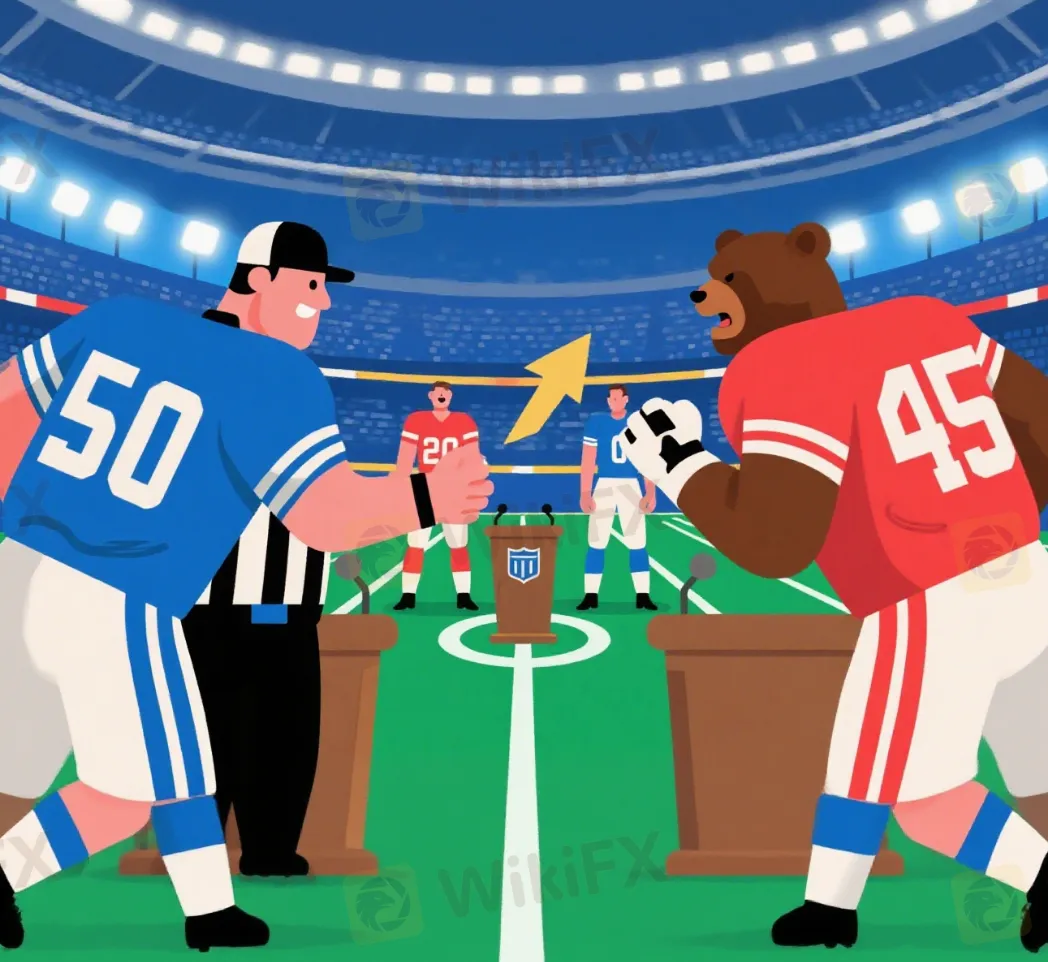Abstract:The NFP isn't a get-rich-quick scheme. It's a force of nature in financial markets. Respect the volatility, be patient, and prioritize protecting your money above all else. By doing this, you can navigate NFP releases not with fear, but with the confidence of a prepared and disciplined trader.
In forex trading, few events get as much attention as the Non-Farm Payroll (NFP) report. For traders, the first Friday of every month is like the Super Bowl of economic news. It brings extreme price swings, big risks, and huge opportunities. But what exactly is it? And why does it shake up the currency markets so much?

Here's the simple answer: The Non-Farm Payroll report measures job creation in the United States. It shows how healthy the U.S. economy is.
The U.S. dollar is the world's main currency. When the U.S. economy does well or poorly, it affects all currency pairs. This guide will take you from beginner to expert. We'll explain what the NFP is and why it moves markets so much. You'll learn how to read the report like a pro and get practical trading strategies.
Understanding the NFP Report
To trade the NFP, you need to understand what's in it. It's not just one number. It's a complete picture of the U.S. job market.
A Deeper Definition
The Non-Farm Payroll report comes out monthly from the U.S. Department of Labor's Bureau of Labor Statistics (BLS). It counts all paid U.S. workers except for a few groups. These excluded groups are government workers, household employees, non-profit workers, and farm workers. Understanding what is nfp in forex means knowing this report covers about 80% of workers who help create the country's total economic output. This makes it one of the best ways to see how the American economy is doing right now.
What the Report Includes
The main number gets the most attention. But smart traders look at several parts of the report to get the full story.
- The Headline Number: This shows how many new jobs were added or lost last month. News outlets talk about this number the most.
- The Unemployment Rate: This is the percentage of people without jobs who are actively looking for work. When this number falls, it usually means the economy is strong.
- Average Hourly Earnings: This measures how much businesses pay workers per hour. It's important for predicting inflation. When wages rise quickly, prices might go up too.
- Labor Force Participation Rate: This shows what percentage of working-age people either have jobs or are looking for them. A rising rate often means people feel confident about finding work.
Release Schedule and Source
Knowing when and where to get the data matters for traders. The NFP report always comes out on the first Friday of each month at 8:30 AM Eastern Time.
You need to get accurate information fast. The best place to find the data right when it's released is the U.S. Bureau of Labor Statistics (BLS) website. Many news sites and trading platforms share the numbers too. But the BLS is where it all starts.
Why NFP Moves Markets
One data release can make currency pairs move hundreds of points in minutes. This might seem crazy. The NFP has this much power because it directly affects what the world's most important central bank does. That's the U.S. Federal Reserve (the Fed).
The Fed Link
The Federal Reserve has two main jobs. First, get as many people employed as possible. Second, keep prices stable by controlling inflation. The NFP report gives a direct update on the first job.

Here's how it works: A strong NFP report means lots of new jobs and low unemployment. This signals a healthy, growing economy. When the economy booms, inflation can happen. More people with jobs spend more money, which drives up prices. To fight this inflation, the Fed's main tool is raising interest rates.
Higher interest rates make holding a currency more attractive to foreign investors. They can earn better returns. This makes more people want U.S. dollars, so the dollar's value goes up against other currencies. On the flip side, a weak NFP report signals a slowing economy. This makes the Fed consider lowering interest rates to boost growth. Lower rates make the dollar less attractive, so its value falls.
The Economic Chain Reaction
To really understand market reactions, let's look at the step-by-step thinking that big traders and computer programs follow right after the release.
Scenario A: Strong NFP (Better than expected)
Report: High job growth and rising wages are announced.
Interpretation: The U.S. economy is strong and growing.
Fed Expectation: Markets immediately expect the Fed will raise interest rates to prevent the economy from overheating.
Market Impact: Demand for U.S. dollars surges as investors expect higher returns.
Forex Result: The dollar strengthens a lot. Pairs like EUR/USD and GBP/USD fall. Pairs like USD/JPY and USD/CAD rise.
Scenario B: Weak NFP (Worse than expected)
- Report: Low job growth, job losses, or flat wages are announced.
- Interpretation: The U.S. economy is weakening or heading for recession.
- Fed Expectation: Markets expect the Fed will lower interest rates to boost economic activity.
- Market Impact: Demand for U.S. dollars drops as investors expect lower returns.
- Forex Result: The dollar weakens a lot. Pairs like EUR/USD and GBP/USD rise. Pairs like USD/JPY and USD/CAD fall.
Affected Currency Pairs
The NFP is a U.S. report, but it affects markets worldwide. The assets that see the biggest price swings are those directly tied to the U.S. dollar.
- Major Pairs: All major currency pairs with the dollar see huge volatility spikes. This includes EUR/USD, GBP/USD, USD/JPY, AUD/USD, and USD/CAD. These are the main battlegrounds during NFP.
- Gold (XAU/USD): Gold is priced in U.S. dollars and often moves opposite to the currency. A strong dollar from good NFP data typically makes gold more expensive for foreign buyers. This pushes gold prices down. A weak dollar often does the opposite.
- Stock Indices: U.S. stock indices like the S&P 500 and Nasdaq are also heavily affected. A strong jobs report is often good for company earnings and the economy. This can boost stock prices. But fear of higher interest rates can sometimes complicate this relationship.
Reading Data Like a Pro
Markets don't just react to the data. They react to how the data compares to what people expected. Understanding this difference separates beginner traders from professionals.
Expectations vs. Actuals
The most important concept in news trading is the “surprise” factor. Weeks before the NFP release, economists publish their forecasts. These forecasts create market expectations.
The big market moves happen when actual numbers are very different from forecasts. If NFP is forecast at +200k and comes in at +205k, the reaction will be small. If it comes in at +300k, the reaction will be huge. Learning what is nfp forex trading means understanding this dynamic between reality and expectations.
Here's how markets typically react:
Don't Forget Revisions
One crucial detail that many people miss is revisions to previous months' data. The BLS often adjusts its initial numbers as more information becomes available.
Picture this scenario: The headline number is a huge beat, but the previous two months get revised down by a lot. The net effect might actually be negative. The initial market reaction might be positive on the headline. But as big traders digest the revisions, prices can reverse sharply. Always check the revisions. They provide important context.
The “Whisper Number”
There's also the unofficial “whisper number.” This refers to informal expectations that circulate among large financial institutions and well-connected traders. Sometimes the market feels the official forecast is wrong. If the actual number meets the official forecast but falls short of a higher whisper number, the market might still sell off. This leaves many retail traders confused. While you can't know whisper numbers for certain, being aware of this can help explain seemingly strange price moves.
A Practical Trading Guide
Knowing the theory is one thing. Applying it in a live market with real money is completely different. This section gives you a framework for action. We focus heavily on safety and risk management.
The Golden Rule
Every trader should first ask: “Should I even trade the NFP?” For absolute beginners, the most profitable strategy is often not trading at all. Instead, watch the price action. Study the reaction and learn without risking money.
NFP trading is an advanced skill. The volatility is extreme. Spreads widen dramatically, and slippage is common. It's not an environment for unprepared traders. If you choose to participate, you must have a clear plan and strict commitment to risk management.
The Pre-NFP Checklist
Professional traders don't just show up and start clicking buttons. They prepare. Here's a systematic checklist for high-impact news events like the NFP.
- [ ] 72-48 hours before: Check your economic calendar for the consensus NFP forecast. Note the previous month's number and general market sentiment.
- [ ] 24 hours before: Look at your charts. Find major support and resistance levels on higher timeframes like 4-hour and daily charts. These are levels where price is likely to react.
- [ ] 1 hour before: Make two distinct plans. Plan A: What's your strategy if the numbers are strong for the dollar? Plan B: What's your strategy if the numbers are weak?
- [ ] 15 minutes before: Close any open positions that could get whipsawed by volatility. The market often becomes quiet and erratic just before 8:30 AM ET. This isn't a time to hold casual trades.
- [ ] Define Your Risk: Before the release, decide the absolute maximum you're willing to lose. Your stop-loss isn't a suggestion. It's your protection. Determine your entry, stop-loss, and take-profit levels before the market starts moving.
Common NFP Strategies
There are several ways to approach trading the NFP. Each has a different risk level.
- Strategy 1: Trading the Initial Spike (High Risk)
This involves placing pending orders on both sides of the current price just before the release. You're hoping to catch the initial explosive move.
- Warning: This is extremely risky. Price can spike in one direction, trigger your order, then immediately reverse and stop you out. This is called a “whipsaw.” Also, extreme slippage can mean your order gets filled at a much worse price than intended. We don't recommend this for most traders.
- Strategy 2: Fading the Initial Move (Medium to High Risk)
This strategy involves waiting for the initial spike to exhaust itself. Traders then look for signs of a reversal and trade in the opposite direction. They're betting the first move was an overreaction.
- This requires patience and strong technical analysis skills to identify valid reversal signals.
- Strategy 3: Waiting for the Dust to Settle (Lower Risk)
This is our recommended approach for most traders. Instead of trying to trade the chaotic first few minutes, you wait. Let the market digest the numbers for 15-30 minutes. Once initial volatility calms down and a clearer trend forms, you can look for a low-risk entry in the direction of that new trend. This sacrifices the explosive first move for a higher-probability setup.
Non-Negotiable Risk Management
If you ignore everything else, don't ignore this. Trading the NFP without strict risk management is gambling, not trading.
- Use a Stop-Loss: Always. No exceptions. Place it the moment you enter a trade.
- Reduce Your Position Size: Whatever your normal lot size is, consider cutting it in half or even by 75%. Extreme volatility means you can reach your profit target with a much smaller position.
- Be Aware of Slippage: During NFP, price can move so fast that your order might get filled at a very different price than requested. A stop-loss set at 1.0850 might get filled at 1.0835. Factor this potential extra loss into your position sizing.
- Widen Your Spreads: Brokers face risk too. To protect themselves, they significantly widen the spread around NFP release. A typical 1-pip spread on EUR/USD can balloon to 10-20 pips.
A Real-World Example
Let's break down a past NFP release to see these concepts in action.
Case Study: August 2023 NFP
The NFP report for August 2023 was released on September 1, 2023. This is a perfect example of a “mixed report” where the headline number was misleading.
The Setup and Reality
Here's how the data looked:
- Market Forecast: +170,000 jobs expected.
- Actual Release: +187,000 jobs.
- The Details: At first glance, this looked like a solid beat, which should be good for the dollar. However, the details told a different story. The previous two months (June and July) were revised down by a combined -110,000 jobs. The unemployment rate unexpectedly jumped from 3.5% to 3.8%. Wage growth was softer than forecast.
The Market Reaction
Let's look at the EUR/USD pair in the minutes following the release:
- 8:30 AM ET: The numbers hit the news. The headline “+187k” flashes across screens. Algorithms and initial reactions focus on this beat. EUR/USD immediately drops about 50 pips as the dollar strengthens. This is the initial, headline-driven spike.
- 8:35 AM ET: The market has had time to digest the full report. Traders and algorithms now see the huge negative revisions, higher unemployment rate, and weaker wages. The story shifts from “strong report” to “weak report.” Price reverses sharply, erasing the entire drop and rallying back above the pre-release level. This is the classic “whipsaw.”
- 9:00 AM ET: The dust begins to settle. The market decides the negative details outweigh the positive headline. A clearer trend emerges as the dollar weakens. EUR/USD begins a steady climb for the next several hours. This shows why waiting is often the wiser strategy when analyzing what is non farm payroll forex price action. A trader who waited 30 minutes would have seen a clear upward trend to join.
Mastering the NFP
The Non-Farm Payroll report is a cornerstone of the forex market. It's a monthly test of a trader's discipline, preparation, and analytical skill. Approaching it with respect and a solid framework can turn high risk into calculated opportunity.
Your NFP Essentials
If you remember nothing else from this guide, remember these key points:
- NFP is a top-tier U.S. economic report that directly shows economic health and drives massive volatility in forex.
- Analyze the entire report: the headline number, unemployment rate, average hourly earnings, and crucially, revisions to previous months.
- Markets move on surprises (actual vs. forecast), not the absolute number itself.
- Preparation is everything. Use a checklist to analyze the market and form a plan before the release.
- Risk management isn't optional. For most traders, especially beginners, watching the NFP is safer and more educational than actively trading it.
A Final Word
The NFP isn't a get-rich-quick scheme. It's a force of nature in financial markets. Respect the volatility, be patient, and prioritize protecting your money above all else. By doing this, you can navigate NFP releases not with fear, but with the confidence of a prepared and disciplined trader.










